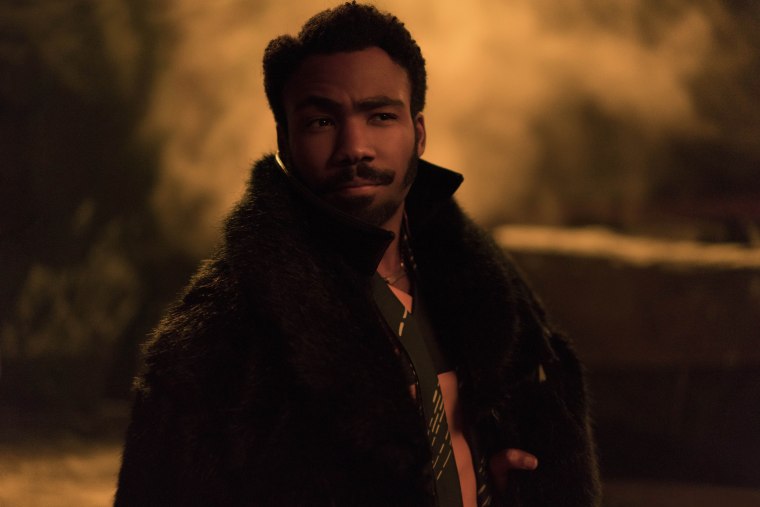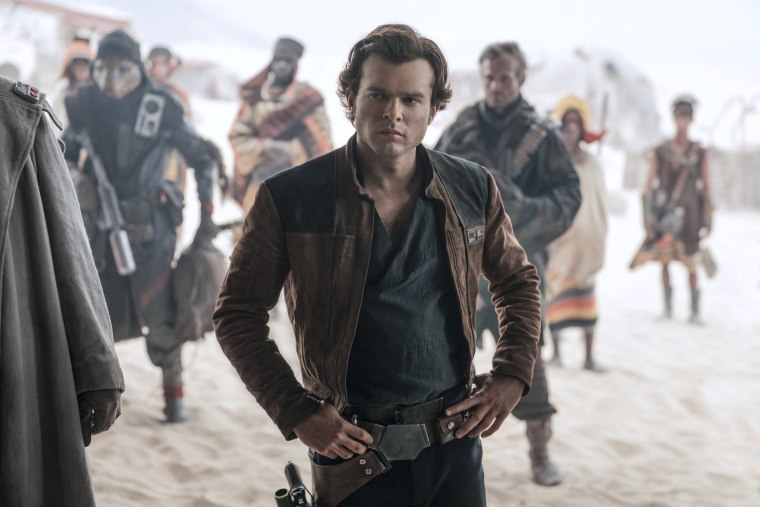“Solo: A Star Wars Story” is the fourth franchise film since Lucasfilm was taken over by Disney; it’s the second so-called anthology film of the series, a way of delineating the live-action, standalone prequels that are separate from the nine episodes of the Skywalker saga. More fun than “Avengers: Infinity War,” less concerned with leaving its mark on the landscape than “Black Panther” and far more family friendly than “Deadpool 2,” “Solo” is an old school blockbuster film that is far more entertaining than it has any right to be.
Make no mistake, “Solo” has problems. They’re nowhere near as bad as the first anthology film, “Rogue One,” but that’s because this one holds together as a single cohesive piece of movie making. (“Rogue One,” in comparison, is composed of the fragments of four different films, bound together with spit, bailing wire, a few outtakes from the “Star Wars: Rebels” cartoon and a random sketch from “Robot Chicken.”) But on paper, “Solo,” as a film, is terrible, and that’s because the script is genuinely, startlingly godawful.
(Please be advised, there are a few spoilers for the film ahead.)

After three films in which Lucasfilm and Disney quietly, successfully diversified the Star Wars universe, the Solo script tears up all the work they’d done and throws a dance party on it. The first human character to die doesn’t just play directly to the science fiction trope of “Black Dude Dies First,” she’s also the first black woman to have a starring role in a Star Wars film. The only other person of color in the film, Lando Calrissian, isn’t even a character; he’s vain clotheshorse played for laughs and a plot device through which our white male hero measures his worth based on how self-conscious he is around someone so much “cooler.” Qi’ra isn’t a person; she’s a template for Han to try out all the lines he’ll use more successfully on Leia in “Empire Strikes Back.” The film spectacularly fails the Bechdel test twice.
And then there’s L3-37. (Yes, her name is a 1980s proto-internet reference.) The PR line on her is that she’s a droid who “built herself out of spare parts,” and “is a freedom fighter for equality for all of droid kind.” None of this is actually in the script. I couldn’t figure out if the writers meant her to be an explicitly feminist butt of jokes, or merely standing in for all minorities who routinely annoy white dudes with their calls for “Equal rights!” But to see her and those calls for equality turned into a big screen punchline in 2018 was as brutal as her ultimate fate.
And yet, for all that, this film is perhaps one of the most enjoyable blockbusters that Star Wars has produced. If it had arrived before “The Last Jedi” it would be the best film Disney-Lucasfilm had done to date. All of that is due to the second director who came aboard the production in its hour of need, Ron Howard.
And yet, for all that, this film is perhaps one of the most enjoyable blockbusters that Star Wars has produced.
Like nearly all the Star Wars films that have come out since Disney took over, “Solo: A Star Wars Story” had a rough road to the big screen. Most don’t remember now, but “Star Wars: The Force Awakens” was so extensively reshot that they had to scrap the “Making Of” companion book. (A $2 billion dollar worldwide box office haul helped drop that down the memory hole.) “Rogue One” was taken away from the first director, Gareth Edwards, had the entire ending rewritten and was subject to another round of extensive reshoots by Tony Gilroy. The result was so awkwardly done that the final product couldn’t hide it.
The backstage drama of “Solo” also became impossible to hide when original directors Phil Lord and Chris Miller were fired in a spectacular fashion with less than three weeks to go before filming was finished. The script was not changed at all, but when veteran director Ron Howard was brought in as a replacement, he reshot so much of the film that Lord & Miller were moved to the “Executive Producer” credit column.
Howard had an advantage coming in. He had worked with Lucas on the film the latter made prior to “Star Wars” — “American Graffiti,” which starred Harrison Ford as a Bob Falfa, now seen as a proto-Han Solo. Howard was just coming into his own as a director when the first Star Wars films hit theaters, and he had a front row seat to seeing Lucas create a successful model on the idea of a spaghetti Western in space. The model of the old-school western is all over “Solo,” and it carries the movie where the script cannot.

Howard made “Solo” an enjoyable film from beginning to end because he focused on texture over text, understanding that what made the original Star Wars films work was old-school blockbuster charm. Alden Ehrenreich sounds nothing like Han Solo and looks nothing like Han Solo (he looks like a cross between Benicio Del Toro and Chris Pine) and yet, from the first shot, you do not doubt this is Young Han. The movie doesn’t really pick up until Chewie shows up and Ehrenreich no longer has to carry the entire film on his shoulders, but that’s not a knock on the movie’s main star. It’s just that the show needs that much charisma simply to stay on the road.
From the sounds of the gossip, one of the major reasons for Lord & Miller’s firing was a refusal to stick to the script. After seeing it, one can see why they turned to improvisation and over-the-top comedy in order to triage what they were handed; they didn't have the depth of experience to figure out how to solve a film with a baseline problem of this nature. Howard, being a far more seasoned filmmaker, understood there was another way to solve a film like this: Get everyone on screen to turn the charm up to 11 and keep it there. The result is so effective that I left the theater thinking I wouldn’t mind a sequel.
Just maybe next time? Get better writers.
Ani Bundel has been blogging professionally since 2010. Regular bylines can be found at Elite Daily, WETA's TellyVisions, and Ani-Izzy.com.
